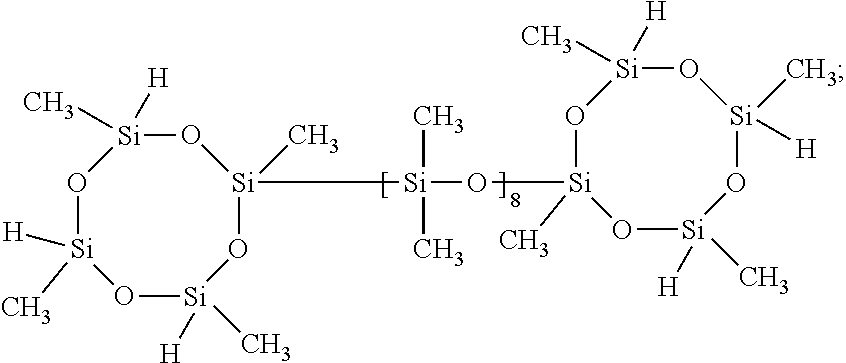Polymerizable Hybrid Polysiloxanes and Preparation
a hybrid polysiloxanes and polymer technology, applied in the field of new hydrophilic silicones, can solve the problems of uncomfortable feeling and poor wettability of body liquids
- Summary
- Abstract
- Description
- Claims
- Application Information
AI Technical Summary
Benefits of technology
Problems solved by technology
Method used
Image
Examples
example 1
Preparation of SiH-Containing Silicone-EO Copolymer with PEO Grafted on Silicone Chain
[0072]To a 500 mL 3-neck flask with a reflux condenser and thermometer, 30.1 g MA-500 (0.0542 mol allyl CH2═CHCH2—), Karstedt's catalyst (15-20 ppm), Tocopherol 95 (130˜200 ppm), 2.25 g α-olefin 8 (0.0201 mol CH2═CH—) and 106 g THF were added to form a cloudy solution. 54.78 g (0.0898 mol SiH) of MD169D23HM was then added to the flask. This cloudy mixture was allowed to react for 4 hours at refluxing temperature (70° C.) to form into one semi-transparent solution. 4-5 ppm of TPP in THF solution was added, and the reaction mixture was changed from cloudy colorless into semi-clear. The product was obtained by stripping the mixture at a reduced pressure at 75° C. to remove THF and other volatile chemicals. A cloudy liquid was collected to form into a clear, colorless liquid at room temperature; the yield was 80.3 g (92.1%). The synthesized sample had a molecular structure of the reactive SiH-containin...
example 2
Preparation of SiH-Containing Silicone-EO Copolymer with PEO Grafted on Silicone Chain
[0073]To a 500 mL 3-neck flask with a reflux condenser and thermometer, 30.4 g MA-500 (0.0547 mol allyl CH2═CHCH2—), Karstedt's catalyst (15-20 ppm), Tocopherol 95 (130˜200 ppm), 1.71 g α-olefin 6 (CH2═CH(CH2)3CH3 (0.0203 mol CH2═CH—) and 98 g THF were added to form a cloudy solution. 55.3 g (0.0907 mol SiH) of MD169D23HM was then added to the flask. This cloudy mixture was allowed to react for 4 hours at refluxing temperature (70° C.) to form into one semi-transparent solution. 4-5 ppm of TPP in THF solution was added, and the reaction mixture was changed from cloudy colorless into semi-clear. The product was obtained by stripping the mixture at a reduced pressure at 75° C. to remove THF and other volatile chemicals. A cloudy liquid was collected to form into a clear, colorless liquid at room temperature; the yield was 79.5 g (90.9%). The synthesized sample had a molecular structure of the reactiv...
example 3
Preparation of SiH-Containing Silicone-EO Copolymer with PEO Grafted on Silicone Chain
[0074]To a 500 mL 3-neck flask with a reflux condenser and thermometer, 30.83 g MA-500 (0.0554 mol allyl CH2═CHCH2—), Karstedt's catalyst (15-20 ppm), Tocopherol 95 (130˜200 ppm), 8.04 g allyl glycidyl ether (0.0704 mol CH2═CHCH2O—), and 122 g THF were added to form a cloudy solution. 93.8 g (0.154 mol SiH) of MD169D23HM was then added to the flask. This cloudy mixture was allowed to react for 4 hours at refluxing temperature (72° C.) to form into one cloudy solution. 4-5 ppm of TPP in THF solution was added, and the reaction mixture was changed from cloudy colorless into semi-clear. The product was obtained by stripping the mixture at a reduced pressure at 80° C. to remove THF and other volatile chemicals. A cloudy liquid was collected to form into a cloudy, white, viscous liquid at room temperature; the yield was 121.5 g (91.5%). The synthesized sample had a molecular structure of the reactive Si...
PUM
| Property | Measurement | Unit |
|---|---|---|
| Pressure | aaaaa | aaaaa |
Abstract
Description
Claims
Application Information
 Login to View More
Login to View More - R&D
- Intellectual Property
- Life Sciences
- Materials
- Tech Scout
- Unparalleled Data Quality
- Higher Quality Content
- 60% Fewer Hallucinations
Browse by: Latest US Patents, China's latest patents, Technical Efficacy Thesaurus, Application Domain, Technology Topic, Popular Technical Reports.
© 2025 PatSnap. All rights reserved.Legal|Privacy policy|Modern Slavery Act Transparency Statement|Sitemap|About US| Contact US: help@patsnap.com



